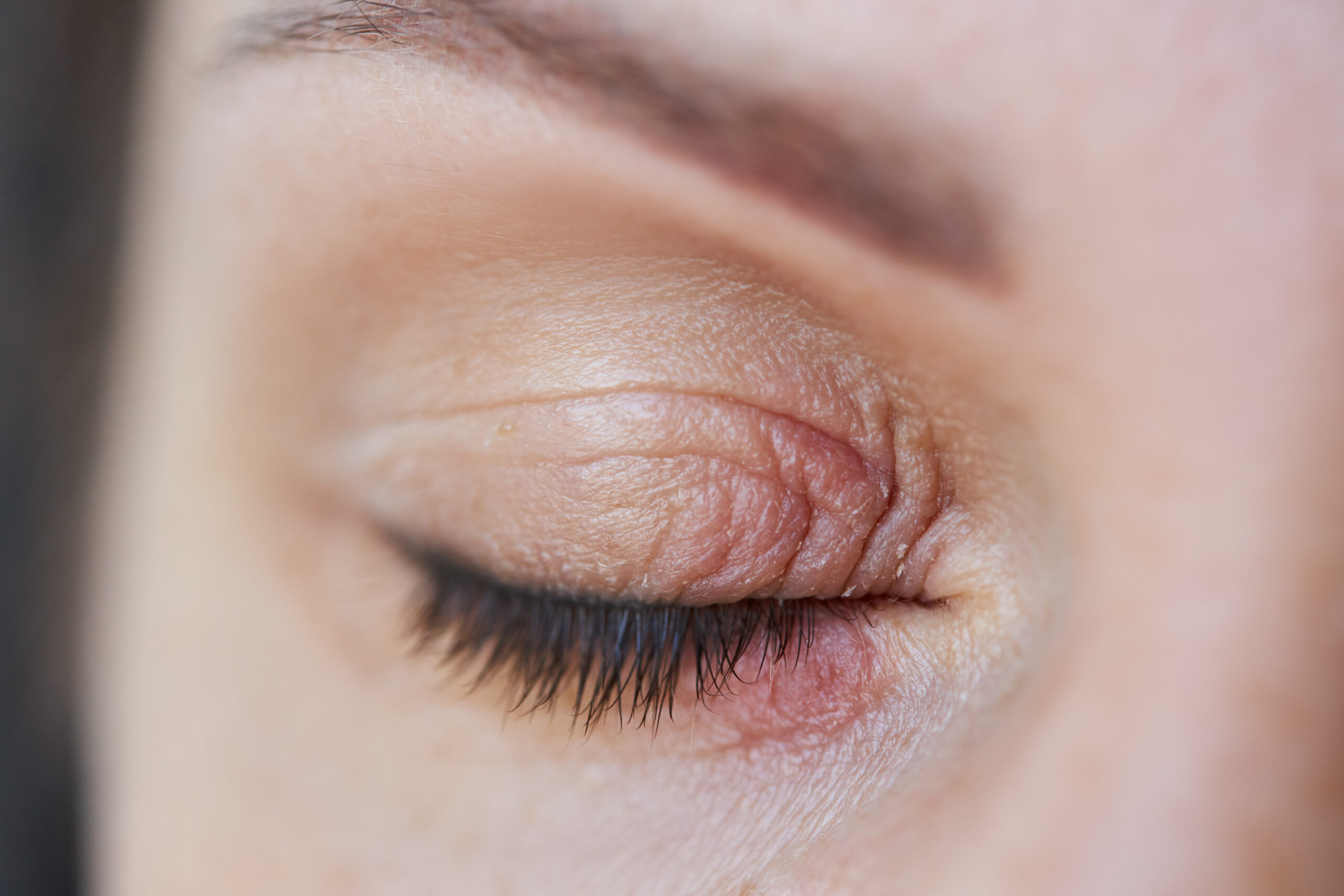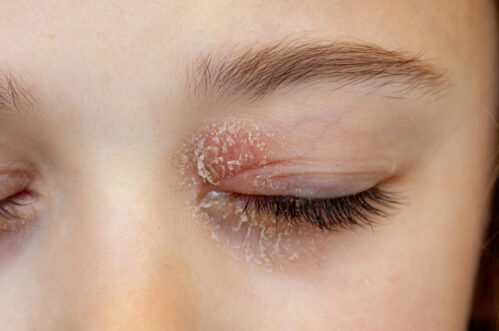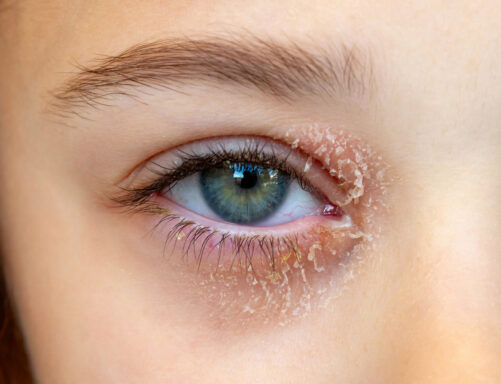Meibomian Gland Dysfunction
Learn about the importance of eyelid cleansing, the role of Meibomian Glands, and how to manage this condition. 

The medical term “dermatitis” means “skin irritation”, thus “eyelid dermatitis” covers a broad variety of eyelid skin rashes, presenting as red, swollen eyelids. It is also called “eyelid eczema”.
The most common causes that induces swelling and redness of the eyelids are contact dermatitis, atopic dermatitis, and blepharitis1. More information on blepharitis can be found in this fact sheet.
Eyelid skin is especially vulnerable to irritants and allergens because of its thinness and frequent exposure to chemicals, via direct application or contamination from fingers and hands1.
Contact dermatitis may be related to allergy or to irritation1. Allergic contact dermatitis involves the immune system reacting against a specific substance called “allergen”, whereas irritant contact dermatitis is the result of toxic substances or physical conditions coming into contact with the eyelids and damaging and irritating the skin2.
Contact dermatitis is more often caused by a product applied to the hair, nails, or face than by products applied directly to the eyelids1. The irritant is then transferred from the contaminated fingers when touching the eyelids.
Irritating substances that may cause irritant contact dermatitis include3:
Physical circumstances may also cause irritant contact dermatitis:
Allergic contact dermatitis is related to 7 main allergen groups. In descending order: metals, shellac, preservatives, topical antibiotics, fragrances, acrylates, and surfactants4.
Metals are part of jewelry, eyelashes curlers and eyewear (glasses), but are also used in cosmetics, such as makeup, nail lacquers, skin cleansers and moisturizers. Of course, the amount of metals in cosmetics is very small, but allergy may be triggered by incredibly tiny amounts of allergens4.
Shellac, preservatives, fragrances, acrylates and surfactants are commonly used in cosmetics, skincare products, perfumes, artificial nails and nail lacquers, soaps and shampoos3,4. Thus, the use of cosmetic products increases the risk of allergies as well as irritative contact dermatitis in eyelids, which probably explains why women are much more frequently affected than men5.
Eyelid contact dermatitis may also be triggered by airborne allergens, such as dust mite and pollens3.

Atopic dermatitis is a chronic skin disease caused by an abnormal response of the immune system and a very dry, itchy skin that does not play fully its protective role of barrier6, which makes it prone to irritant and allergic dermatitis2. It usually starts in childhood and is often associated to allergic diseases such as asthma or hay fever5. In most cases, there is a family history of atopic dermatitis and allergy1.
The eyelids with dermatitis are swollen and red, with an itching, burning or stinging feeling, and sometimes with small clear blisters1. As time goes by, chronic inflammation causes a fine scaling, and the skin becomes thicker and hard, with fine cracks1.
Timing of onset can help the diagnosis: allergic contact dermatitis typically occurs within 24-96 hours following contact with the allergen, whereas irritant contact dermatitis appears shortly after exposure to the irritant5.
It is said that swelling and redness are more pronounced in contact dermatitis than in atopic dermatitis, which more often involves scaling and skin thickening1. But actually, both types of dermatitis look very alike, especially when atopic dermatitis is complicated by allergic or irritant contact dermatitis1 and the two diseases overlap.
The skin affected by dermatitis may also become infected, causing weeping and yellow crusting2.
In atopic dermatitis, people often have allergic diseases and other areas of the skin are affected.
In contact dermatitis, to identify the causative agent may be tricky as there are many of them, widespread in our environment and daily routines. To make identification more difficult, the products involved in the dermatitis may have been applied directly on the eyelids, but also may have been transferred from the hands by rubbing or scratching the eyes3.
As cosmetics are frequently involved, you can remove all of them (including nail varnish, perfume sprays and hair dye) during a few days: if your eyelids improve, the culprit is among the withdrawn products. You will know which one is responsible by reintroducing them one by one and monitoring if the symptoms come back2. This is close to a criminal inquiry, but worth the pain to solve the puzzle and get rid of the offender.

If you are not able to reach a conclusion by yourself, and if the dermatitis persists, you should consult a dermatologist2, who will be more aware of possible irritants or allergens, and will investigate thoroughly your occupation, hobbies and activities for clues.
In case of airborne allergens such as pollen, animal hair or dust mites, other forms of allergy such as asthma, hay fever or allergic conjunctivitis are often associated.
If an allergy is suspected, patch tests may be performed by an allergologist3. This involves applying several suspected allergens on different small skin areas for 48 hours. Reactions usually take 48–96 hours to develop, thus the test is read 96 hours after application. If you are allergic to one of the tested products, a patch of dermatitis will occur at the application site of the offending allergen, with redness, possible swelling and vesicles or even blisters7. Patch tests are valid only for allergic dermatitis and cannot help in irritant dermatitis6.
Contact dermatitis needs total avoidance of the offending agent, either irritant or allergen1.
The first line treatment for dermatitis are emollients8. Those are actually moisturizers with ingredients that soften and smooth the skin.
Short courses (5 to 10 days) of local mild steroid may be prescribed to control inflammation1. Steroid should be progressively discontinued once symptoms have improved, by tapering the dose, in order to prevent a rebound flare of the dermatitis that may occur when steroids are abruptly withdrawn5. Topical calcineurin inhibitors may be applied twice a day for short periods to mitigate the flares, or twice a week on non-consecutive days as maintenance treatment. When using topical calcineurin inhibitors, sun protection is mandatory: sunblock, hat and sunglasses2.
Allergic contact dermatitis and atopic dermatitis involve the same treatments, with the addition of oral antihistamine for atopic dermatitis1 that aims to cool down the immune allergic reaction.
When atopic dermatitis is widespread on the body and affects the quality of life, other oral or injectable specific treatments are recommended8.
In general, don’t hesitate to ask your pharmacist for advice if you have any eye symptoms.
On the other hand, if you experience one or more of these symptoms, you should see an eye specialist as a matter of urgency; -Moderate,-Severe pain, -Intense sensitivity to light, -Decreased vision, -Flashes of light, -Dark spots, -Sensation of a foreign object in the eye, -Trauma (injury, contusion, acid burn etc.), -Persisting or worsening symptoms despite appropriate treatment.
